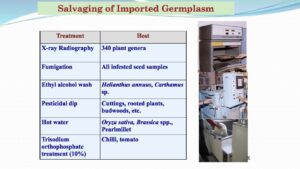Treatments
Several treatment options are available. Thermal options are heat (hot water immersion, force hot air, vapour heat and dry heat) and cold treatments. Chemical options are seed treatment, soil drench, dipping and fumigant options are methyl bromide and phosphine. Control atmospheric temperature and irradiation are other options.
Experimentation to standardise the treatments needs to be done based on exporting and importing country regulations, host and pest involved. Thermal tolerance of fruit flies are within the range of 2 to 460C for both temperate and tropical fruit flies. Hot water is used to raise the temperature of host pulp to eradicate fruit flies to a level of 46.1 to 47.80C. Mango exporters to Europe need to give hot water immersion at the temperature of 480C at least 4” below the water surface for duration ranging from 60 to 90 Mts with mesh netting based on fruit weight and importing country requirements. South Korea, EU, New Zealand and Iran need hot water treatment as described above. In case of vapour heat treatment, pulp temperature is raised to 43.3 to 44.40C in a time line of 6 to 8 hours and then the temperature held for a specified time based on commodity and pest. This treatment is recommended for export of mangoes to Japan, New Zealand, South Korea, EU and Mauritius. All Indian mango varieties need to be exposed to vapour heat treatment to a range of 46.5 to 480C ranging from 20 to 30 mts. Dragon fruit and papaya are also treated with vapour heat in the same range. Niger imports to USA have to be teated with dry heat for at least 15 mts at 1200C. Dry heat or glyphosate is used to devitalise buds and cuttings of roses and carnations under export to Australia.
Cold treatment is recommended for oriental fruit fly in oranges at a temperature of ≤1.70C for a minimum of 15 days. In case of Queensland fruit fly (16 days) and Mediterranean fruit fly (20 days) cold treatment is at 30C or below as pre-shipment or in-transit. Grapes to be exported to China need to be treated at 1.10C or below for 15 consecutive days to eradicate Bractocera dorsalis and Phoma glomerata. Timber logs and wood packaging material is treated with Forced Hot air treatment at 560C for 30 mts. Modified or Controlled atmosphere chambers are used to treat peaches, apple and sweet cherry to eradicate codling moth, oriental and Western cherry fruit flies with final chamber temperature ranging from 45 to 470C with treatment time ranging from 25 mts to 3 hours. Chambers having 8% carbon dioxide, 13% oxygen and 79% nitrogen. Fresh banana is shipped under refrigeration at 130C and humidity maintained at 90-95%.
Irradiation is broad-spectrum rapid post harvest treatment. Irradiated fruits and vegetables are safe for consumption. Since, temperature, humidity or pressure is regulated irradiation can be applied in final packing of products. In order to export mango to USA/Australia minimum dose is 400 Gy. Gamma rays are emitted by radioisotopes such as Cobalt-60 and Caesium-137 while electrons and X-rays are generated by machines using electricity. No residue is left with irradiation and the products are ready for immediate use after the treatment.
Most commonly used fumigants are methyl bromide and phosphine. Other options are sulfuryl fluoride, methyl iodide, carbonyl sulfide, ozone, ethyl formate, ethanedinitrile and ammonia. Fumigation process could be fogs, aerosols, mists and smokes. Methyl bromide fumigation is mandatory to export peanuts to Vietnam @ 100 g/Cu.M, while it 80 g/ Cu.M for rice to be ex-
ported to USA. Grains and dry fruits are fumigated @ 32g/ Cu.M for 24 hrs at 210C, half this

